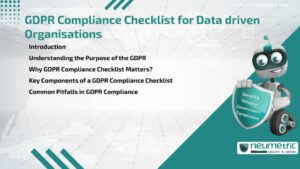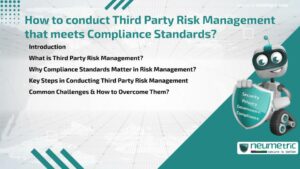Table of Contents
ToggleIntroduction
Knowing How to conduct Third Party Risk Management is essential for Organisations that depend on Vendors, Suppliers or External Service Providers. Regulatory Frameworks like SOC 2, ISO 27001 & GDPR require Companies to assess & manage the Risks posed by Third Parties. A Well-structured approach helps meet Compliance Standards, protect Sensitive Data & ensure Business Continuity.
What is Third Party Risk Management?
Third Party Risk Management refers to the Structured Process of identifying, assessing & controlling potential Risks that stem from an Organisation’s External Relationships, such as Vendors, Suppliers, Contractors, Consultants or Service Providers. These Third Parties often have access to Sensitive Systems, Confidential Data or Critical Business Operations, which introduces a wide range of Security & Compliance concerns.
These Risks can manifest in Several ways:
- Data Breaches resulting from poor Security Practices by the Third Party.
- Operational Disruptions due to Vendor Outages or Performance Failures.
- Regulatory Violations if the Third Party fails to comply with Legal or Contractual Requirements.
- Reputational Damage arising from a Third Party’s Unethical or Non-compliant behaviour.
As Business ecosystems become more interconnected & reliant on External Services, especially in Cloud, SaaS & Outsourced IT Environments, Third Party Risk Management has become essential for maintaining resilience, protecting Customer Data & Meeting Compliance obligations such as GDPR, SOC 2, ISO 27001 & other Frameworks.
A Well-structured Third Party Risk Management Program typically includes due diligence during Onboarding, Regular Assessments, Contractual Safeguards, Performance Monitoring & Incident Response Planning.
Why Compliance Standards Matter in Risk Management?
Compliance Standards such as ISO 27001, SOC 2 & GDPR require Organisations to demonstrate due diligence in managing Third Party Risks. Failing to do so can lead to Audits, Penalties or Loss of Client Trust.
Key Steps in Conducting Third Party Risk Management
To understand How to conduct Third Party Risk Management that meets Compliance Standards, follow these Core steps:
- Inventory Third Parties: Maintain a list of all Vendors & Service Providers.
- Classify Risk Levels: Segment Third Parties based on access to Sensitive Data or Systems.
- Perform Risk Assessments: Evaluate the Vendor’s Security Posture, Compliance History & Operational reliability.
- Define Controls: Require contracts with Security & Compliance Clauses, such as Data Processing Agreements (DPAs).
- Monitor Continuously: Reassess High-risk Vendors regularly, especially after Incidents or Business changes.
Common Challenges & How to Overcome Them?
Challenges include lack of visibility, insufficient documentation & varying Vendor capabilities. To overcome these, use Tools that Automate Assessments & Standardize evaluations. Engage Stakeholders from Legal, IT & Procurement Teams for better Coordination.
Takeaways
- Knowing How to conduct Third Party Risk Management ensures Compliance & Protects your Organisation.
- Start by identifying & classifying Third Parties by Risk Exposure.
- Assess, Monitor & Document Risks using Industry-aligned Frameworks.
- Enforce Security Standards through Well-drafted Contracts.
FAQ
What is Third Party Risk in Compliance?
It refers to potential Risks introduced by Vendors that can affect Regulatory Compliance & Data Protection.
How often should Vendor Risks be reviewed?
At least once a year or when there are significant changes to the Vendor’s Services or Environment.
Are Vendor Questionnaires enough for Risk Assessment?
No. Questionnaires are helpful but should be combined with Audits & Certifications review.
What Standards guide Third Party Risk Management?
Standards include ISO 27001, SOC 2, GDPR & NIST Frameworks.
References
- ISO/IEC 27001 Information Security Standard
- AICPA Trust Services Criteria
- NIST Risk Management Framework
- IT Governance Third Party Risk Tools
Need help for Security, Privacy, Governance & VAPT?
Neumetric provides organisations the necessary help to achieve their CyberSecurity, Compliance, Governance, Privacy, Certifications & Pentesting needs.
Organisations & Businesses, specifically those which provide SaaS & AI Solutions in the Fintech, BFSI & other regulated sectors, usually need a CyberSecurity Partner for meeting & maintaining the ongoing Security & Privacy needs & requirements of their Enterprise Clients & Privacy conscious Customers.
SOC 2, ISO 27001, ISO 42001, NIST, HIPAA, HECVAT, EU GDPR are some of the Frameworks that are served by Fusion – a SaaS, multimodular, multitenant, centralised, automated, CyberSecurity & Compliance Management system.
Neumetric also provides Expert Services for technical Security which covers VAPT for Web Applications, APIs, iOS & Android Mobile Apps, Security Testing for AWS & other Cloud Environments & Cloud Infrastructure & other similar scopes.
Reach out to us by Email or filling out the Contact Form…





